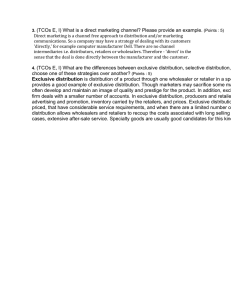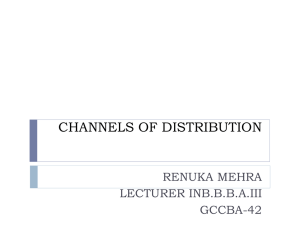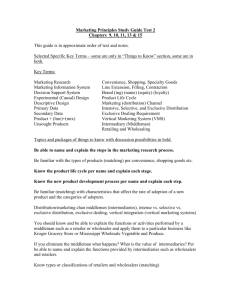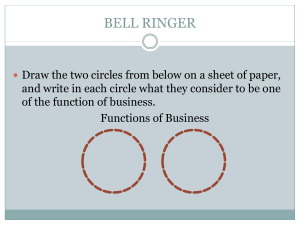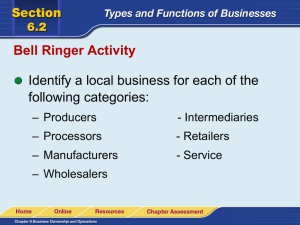wk4_Checkpoint3
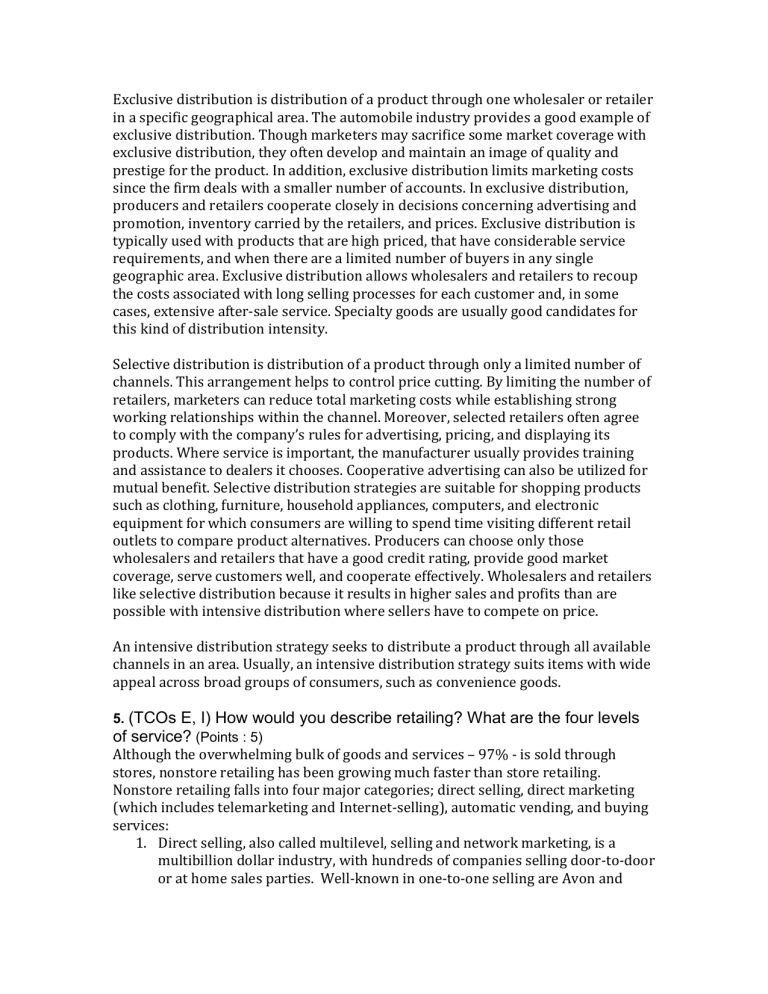
Exclusive distribution is distribution of a product through one wholesaler or retailer in a specific geographical area. The automobile industry provides a good example of exclusive distribution. Though marketers may sacrifice some market coverage with exclusive distribution, they often develop and maintain an image of quality and prestige for the product. In addition, exclusive distribution limits marketing costs since the firm deals with a smaller number of accounts. In exclusive distribution, producers and retailers cooperate closely in decisions concerning advertising and promotion, inventory carried by the retailers, and prices. Exclusive distribution is typically used with products that are high priced, that have considerable service requirements, and when there are a limited number of buyers in any single geographic area. Exclusive distribution allows wholesalers and retailers to recoup the costs associated with long selling processes for each customer and, in some cases, extensive after-sale service. Specialty goods are usually good candidates for this kind of distribution intensity.
Selective distribution is distribution of a product through only a limited number of channels. This arrangement helps to control price cutting. By limiting the number of retailers, marketers can reduce total marketing costs while establishing strong working relationships within the channel. Moreover, selected retailers often agree to comply with the company’s rules for advertising, pricing, and displaying its products. Where service is important, the manufacturer usually provides training and assistance to dealers it chooses. Cooperative advertising can also be utilized for mutual benefit. Selective distribution strategies are suitable for shopping products such as clothing, furniture, household appliances, computers, and electronic equipment for which consumers are willing to spend time visiting different retail outlets to compare product alternatives. Producers can choose only those wholesalers and retailers that have a good credit rating, provide good market coverage, serve customers well, and cooperate effectively. Wholesalers and retailers like selective distribution because it results in higher sales and profits than are possible with intensive distribution where sellers have to compete on price.
An intensive distribution strategy seeks to distribute a product through all available channels in an area. Usually, an intensive distribution strategy suits items with wide appeal across broad groups of consumers, such as convenience goods.
5.
(TCOs E, I) How would you describe retailing? What are the four levels of service?
(Points : 5)
Although the overwhelming bulk of goods and services – 97% - is sold through stores, nonstore retailing has been growing much faster than store retailing.
Nonstore retailing falls into four major categories; direct selling, direct marketing
(which includes telemarketing and Internet-selling), automatic vending, and buying services:
1.
Direct selling, also called multilevel, selling and network marketing, is a multibillion dollar industry, with hundreds of companies selling door-to-door or at home sales parties. Well-known in one-to-one selling are Avon and
Electrolux. Tupperware and Mary Kay Cosmetics are sold one-to-many: A sales-person goes to the home of a host who has invited friends; the salesperson demonstrates the products and takes orders. Pioneered by
Amway, the multilevel (network) marketing sales system works by recruiting independent businesspeople who act as distributors. The distributor’s compensation includes a percentage of sales made by those he or she recruits, as well as earnings on direct sales to customers. These direct-selling firms, now finding fewer consumers at home, are developing multidistribution strategies.
2.
Direct marketing has roots in direct-mail and catalog marketing (Lands’ End,
L.L Bean); it includes telemarketing (1-800-FLOWERS), television directresponse marketing (Home Shopping Network, QVC), and electronic shopping (Amazon.com). As people become more accustomed to shopping on the Internet, they are ordering a greater variety of goods and services from a wider range of Web sites. In the United States, online sales were estimated to be 25% higher in 2005 versus 2004. Travel was the biggest category ($64 billion), followed by computer equipment and software ($14 billion), automobiles ($13 billion), clothing ($11 billion), and home furnishings ($8 billion).
3.
Automatic vending offers a variety of merchandise, including impulse goods such as cigarettes, soft drinks, coffee, candy, newspapers, magazines and other products such as hosiery, cosmetics, hot food, condoms, and paperbacks. Vending machines are found in factories, offices, large retail stores, gasoline stations, hotels, restaurants, and many other places. They offer 24-hour selling, self-service, and merchandise that is always fresh.
Japan has the most vending machines per person-Coca Cola has over 1 million machines there and annual vending sales of $50 billion- twice that in the United States.
4.
Buying service is a storeless retailer serving a specific clientele-usually employees of large organizations-who are entitled to buy from a list of retailers that have agreed to give discounts in return for membership.
5.
(TCOs E, I) Why do intermediaries bother to sponsor their own brand? What is the role of private label brands in the market place?
(Points : 5)
Intermediaries bother to sponsor their own brand because of the difficulty, cost or effectiveness of working with the dominant channel. If the company pays for store shelf space in a major retail store, such as Target, the consumer could find another item on the next section of shelf and pick that up instead. A private-label brand (also called a reseller, store, house, or distributor brand) is a brand that retailers and wholesalers develop. Benetton, The Body Shop and Marks and
Spencer carry mostly own-brand merchandise. For many manufacturers, retailers can be both collaborators and competitors. X
Intermediaries bother to sponsor their own brand because first, they can be more profitable. Intermediaries search for manufacturers with excess capacity that will produce the private label at a low cost. Other costs, such as research and
development, advertising, sales promotion, and physical distribution are also much lower, so private labels can be sold at a lower price yet generate a higher profit margin. I used to work for a company www.tripleimagecosmetics.com
that offered private label. Say, you are a celebrity, J Lo. They use private label based on customized instructions on how they want it. Second, retailers develop exclusive store brands to differentiate themselves from competitors. Many consumers prefer store brands in certain categories.
7.
(TCOs E, I) Describe wholesaling. Why do manufacturers not sell directly to retailers or final customers?
(Points : 5)
Wholesaling includes all the activities in selling goods or services to those who buy for resale or business use. It excludes manufacturers and farmers because they are engaged primarily in production, and it excludes retailers.
Manufacturers do not sell directly to retailers or final customers because in general, wholesalers are more efficient in performing one or more of the following functions: a) Selling and promoting. Wholesalers’ sales forces help manufacturers reach many small business customers at a relatively low cost. They have more contacts, and buyers often trust them more than they trust a distant manufacturer. b) Buying and assortment building. Wholesalers are able to select items and build the assortments their customers need, saving them considerable work. c) Bulk breaking. Wholesalers achieve savings for their customers by buying large carload lots and breaking the bulk into smaller units. d) Warehousing. Wholesalers hold inventories, thereby reducing inventory costs and risks to suppliers and customers. e) Transportation. Wholesalers can often provide quicker delivery to buyers because they are also closer to the buyers. f) Financing. Wholesalers finance customers by granting credit, and finance suppliers by ordering early and paying bills on time. g) Risk bearing. Wholesalers absorb some risk by taking title and bearing the cost of theft, damage, spoilage, and obsolescence. h) Market information. Wholesalers supply information to suppliers and customers regarding competitor’s activities, new products, price developments, and so on. i) Management services and counseling. Wholesalers often help retailers improve their operations by training sales clerks, helping with store layouts and displays, and setting up accounting and inventory-control systems. They may help industrial customers by offering training and technical services.
8.
(TCOs E, I) Explain supply chain management and market logistics. Why are these efficient processes important to many industries?
(Points : 5)
Physical distribution starts at the factory. Managers choose a set of warehouses
(stocking points) and transportation carriers that will deliver the goods to final destinations in the desired time or at the lowest total cost. Physical distribution has
now been expanded into the broader concept of supply chain management (SCM).
Supply chain management starts before physical distribution and means strategically procuring the right inputs (raw material, components, and capital equipment); converting them efficiently into finished products; and dispatching them to the final destinations.
Market logistics includes planning the infrastructure to meet demand, then implementing and controlling the physical flows of materials and final goods from points of origin to points of use, to meet customer requirements at a profit.
Studying market logistics leads managers to find the most efficient way to deliver value. For example, a software company normally sees its challenge as producing and packaging software disks and manuals, then shipping them to wholesalers- who ship them to retailers, who sell them to customers. Customers bring the software package to the home or office and download the software onto a hard drive. Market logistics would look at two superior delivery systems. The first includes ordering the software to be downloaded directly onto the customer’s computer. The second system allows the computer manufacturer to download the software onto its products. Both solutions eliminate the need for printing, packaging, shipping, and stocking millions of disks and manuals. The same solutions are available for distributing music, newspapers, video games, films and other products that deliver voice, text, data or images.

